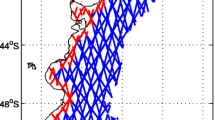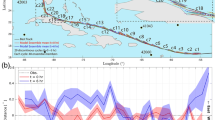Abstract
Observing system simulation experiments are performed using an ensemble Kalman filter to investigate the impact of surface observations in addition to radar data on convective storm analysis and forecasting. A multi-scale procedure is used in which different covariance localization radii are used for radar and surface observations. When the radar is far enough away from the main storm so that the low level data coverage is poor, a clear positive impact of surface observations is achieved when the network spacing is 20 km or smaller. The impact of surface data increases quasi-linearly with decreasing surface network spacing until the spacing is close to the grid interval of the truth simulation. The impact of surface data is sustained or even amplified during subsequent forecasts when their impact on the analysis is significant. When microphysics-related model error is introduced, the impact of surface data is reduced but still evidently positive, and the impact also increases with network density. Through dynamic flow-dependent background error covariance, the surface observations not only correct near-surface errors, but also errors at the mid- and upper levels. State variables different from observed are also positively impacted by the observations in the analysis.















Similar content being viewed by others
References
Anderson JL, Wyman B, Zhang S, Hoar T (2005) Assimilation of surface pressure observations using an ensemble filter in an idealized global atmospheric prediction system. J Atmos Sci 62:2925–2938
Bratseth AM (1986) Statistical interpolation by means of successive corrections. Tellus 38A:439–447
Brewster K (1996) Application of a Bratseth analysis scheme including Doppler radar data. In: Preprints, 15th Conf Wea Anal Forecasting, Norfolk, VA, Amer Meteor Soc, pp 92–95
Compo GP, Whitaker JS, Sardeshmukh PD (2006) Feasibility of a 100 year reanalysis using only surface pressure data. Bull Am Meteor Soc 87:175–190
Dawson DT II, Xue M (2006) Numerical forecasts of the 15–16 June 2002 Southern Plains severe MCS: impact of mesoscale data and cloud analysis. Mon Wea Rev 134:1607–1629
Doviak R, Zrnic D (1993) Doppler radar and weather observations, 2nd edn. Academic Press, San Diego
Dowell D, Zhang F, Wicker LJ, Snyder C, Crook NA (2004) Wind and temperature retrievals in the 17 May 1981 Arcadia, Oklahoma supercell: ensemble Kalman filter experiments. Mon Wea Rev 132:1982–2005
Evensen G (2003) The ensemble Kalman filter: Theoretical formulation and practical implementation. Ocean Dyn 53:343–367
Fujita T, Stensrud DJ, Dowell DC (2007) Surface data assimilation using an ensemble Kalman filter approach with initial condition and model physics uncertainties. Mon Wea Rev 135:1846–1868
Gaspari G, Cohn SE (1999) Construction of correlation functions in two and three dimensions. Quart J Roy Meteor Soc 125:723–757
Gilmore MS, Straka JM, Rasmussen EN (2004a) Precipitation and evolution sensitivity in simulated deep convective storms: comparisons between liquid-only and simple ice and liquid phase microphysics. Mon Wea Rev 132:1897–1916
Gilmore MS, Straka JM, Rasmussen EN (2004b) Precipitation uncertainty due to variations in precipitation particle parameters within a simple microphysics scheme. Mon Wea Rev 132:2610–2627
Hacker JP, Rostkier-Edelstein D (2007) PBL state estimation with surface observations, a column model, and an ensemble filter. Mon Wea Rev 135:2958–2972
Hacker JP, Snyder C (2005) Ensemble Kalman filter assimilation of fixed screen-height observations in a parameterized PBL. Mon Wea Rev 133:3260–3275
Hong SY, Lim JOJ (2006) The WRF single-moment 6-class microphysics scheme (WSM6). J Korean Meteor Soc 42:129–151
Houtekamer PL, Mitchell HL (2001) A sequential ensemble Kalman filter for atmospheric data assimilation. Mon Wea Rev 129:123–137
Hu M, Xue M, Gao J, Brewster K (2006) 3DVAR and cloud analysis with WSR-88D level-II data for the prediction of Fort Worth tornadic thunderstorms. Part II: Impact of radial velocity analysis via 3DVAR. Mon Wea Rev 134:699–721
Lin YL, Farley RD, Orville HD (1983) Bulk parameterization of the snow field in a cloud model. J ClimAppl Meteor 22:1065–1092
Liu H, Xue M (2008) Prediction of convective initiation and storm evolution on 12 June 2002 during IHOP. Part I: control simulation and sensitivity experiments. Mon Wea Rev 136:2261–2283
Lord SJ, Kalnay E, Daley R, Emmitt GD, Atlas R (1997) Using OSSEs in the design of the future generation of integrated observing systems. In: 1st symposium on integrated observation systems, Preprint volume. Amer Meteor Soc Long Beach, pp 45–47
Meng Z, Zhang F (2007) Tests of an ensemble Kalman filter for mesoscale and regional-scale data assimilation. Part II: Imperfect model experiments. Mon Wea Rev 135:1403–1423
Meng Z, Zhang F (2008) Tests of an ensemble Kalman filter for mesoscale and regional-scale data assimilation. Part IV: comparison with 3DVar in a month-long experiment. Mon Wea Rev 136:3671–3682
Morss RE, Emanuel KA, Snyder C (2001) Idealized adaptive observation strategies for improving numerical weather prediction. J Atmos Sci 58:210–232
Ray PS, Johnson B, Johnson KW, Bradberry JS, Stephens JJ, Wagner KK, Wilhelmson RB, Klemp JB (1981) The morphology of severe tornadic storms on 20 May 1977. J Atmos Sci 38:1643–1663
Schultz P (1995) An explicit cloud physics parameterization for operational numerical weather prediction. Mon Wea Rev 123:3331–3343
Snook N, Xue M (2008) Effects of microphysical drop size distribution on tornadogenesis in supercell thunderstorms. Geophy Res Lett 35:L24803. doi:10.1029/2008GL035866
Tong M (2006) Ensemble Kalman filer assimilation of Doppler radar data for the initialization and prediction of convective storms. Dissertation, University of Oklahoma
Tong M, Xue M (2005) Ensemble Kalman filter assimilation of Doppler radar data with a compressible nonhydrostatic model: OSS experiments. Mon Wea Rev 133:1789–1807
Tong M, Xue M (2008a) Simultaneous estimation of microphysical parameters and atmospheric state with radar data and ensemble square-root Kalman filter. Part II: parameter estimation experiments. Mon Wea Rev 136:1649–1668
Tong M, Xue M (2008b) Simultaneous estimation of microphysical parameters and atmospheric state with radar data and ensemble square-root Kalman filter. Part I: sensitivity analysis and parameter identifiability. Mon Wea Rev 136:1630–1648
Weckwerth TM, Parsons DB, Koch SE, Moore JA, LeMone MA, Demoz BB, Flamant C, Geerts B, Wang J, Feltz WF (2004) An overview of the International H2O Project (IHOP_2002) and some preliminary highlights. Bull Am Meteor Soc 85:253–277
Whitaker JS, Hamill TM (2002) Ensemble data assimilation without perturbed observations. Mon Wea Rev 130:1913–1924
Whitaker JS, Compo GP, Wei X, Hamill TM (2004) Reanalysis without Radiosondes using ensemble data assimilation. Mon Wea Rev 132:1190–1200
Whitaker JS, Hamill TM, Wei X, Song Y, Toth Z (2007) Ensemble data assimilation with the NCEP global forecast system. Mon Wea Rev 136:463–482
Xu Q, Lu H, Gao S, Xue M, Tong M (2008) Time-expanded sampling for ensemble Kalman filter: assimilation experiments with simulated radar observations. Mon Wea Rev 136:2651–2667
Xue M, Martin WJ (2006) A high-resolution modeling study of the 24 May 2002 case during IHOP. Part I: numerical simulation and general evolution of the dryline and convection. Mon Wea Rev 134:149–171
Xue M, Droegemeier KK, Wong V (2000) The Advanced Regional Prediction System (ARPS)—a multiscale nonhydrostatic atmospheric simulation and prediction tool. Part I: model dynamics and verification. Meteor Atmos Phys 75:161–193
Xue M, Droegemeier KK, Wong V, Shapiro A, Brewster K, Carr F, Weber D, Liu Y, Wang DH (2001) The Advanced Regional Prediction System (ARPS)—a multiscale nonhydrostatic atmospheric simulation and prediction tool. Part II: model physics and applications. Meteor Atmos Phys 76:143–165
Xue M, Wang DH, Gao JD, Brewster K, Droegemeier KK (2003) The Advanced Regional Prediction System (ARPS), storm-scale numerical weather prediction and data assimilation. Meteor Atmos Phys 82:139–170
Xue M, Tong M, Droegemeier KK (2006) An OSSE framework based on the ensemble square-root Kalman filter for evaluating impact of data from radar networks on thunderstorm analysis and forecast. J Atmos Ocean Tech 23:46–66
Xue M, Jung Y, Zhang G (2007) Error modeling of simulated reflectivity observations for ensemble Kalman filter data assimilation of convective storms. Geophys Res Lett 34:L10802. doi:10.1029/2007GL029945
Zhang F, Snyder C, Sun J (2004) Impacts of initial estimate and observations on the convective-scale data assimilation with an ensemble Kalman filter. Mon Wea Rev 132:1238–1253
Zhang F, Meng Z, Aksoy A (2006) Tests of an ensemble Kalman filter for mesoscale and regional-scale data assimilation. Part I: perfect model experiments. Mon Wea Rev 134:722–736
Acknowledgments
We thank Dr. Mingjing Tong for her assistance and helpful discussions on the ARPS EnKF assimilation system, and Nathan Snook for proofreading the manuscript. This work was primarily supported by NSF grants AGS-0331594, AGS-0802888 and OCI-0905040. Ming Xue was also supported by NSF grants AGS-0750790, AGS-0608168 and EEC-0313747, Computations were performed at the Pittsburgh Supercomputing Center (PSC) and Oklahoma Supercomputing Center for Research and Education (OSCER).
Author information
Authors and Affiliations
Corresponding author
Additional information
Responsible editor: F. Mesinger.
Rights and permissions
About this article
Cite this article
Dong, J., Xue, M. & Droegemeier, K. The analysis and impact of simulated high-resolution surface observations in addition to radar data for convective storms with an ensemble Kalman filter. Meteorol Atmos Phys 112, 41–61 (2011). https://doi.org/10.1007/s00703-011-0130-3
Received:
Accepted:
Published:
Issue Date:
DOI: https://doi.org/10.1007/s00703-011-0130-3




